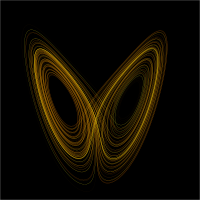
Photo from wikipedia
The attractor neural network scenario is a popular scenario for memory storage in the association cortex, but there is still a large gap between models based on this scenario and… Click to show full abstract
The attractor neural network scenario is a popular scenario for memory storage in the association cortex, but there is still a large gap between models based on this scenario and experimental data. We study a recurrent network model in which both learning rules and distribution of stored patterns are inferred from distributions of visual responses for novel and familiar images in the inferior temporal cortex (ITC). Unlike classical attractor neural network models, our model exhibits graded activity in retrieval states, with distributions of firing rates that are close to lognormal. Inferred learning rules are close to maximizing the number of stored patterns within a family of unsupervised Hebbian learning rules, suggesting that learning rules in ITC are optimized to store a large number of attractor states. Finally, we show that there exist two types of retrieval states: one in which firing rates are constant in time and another in which firing rates fluctuate chaotically.
Journal Title: Neuron
Year Published: 2018
Link to full text (if available)
Share on Social Media: Sign Up to like & get
recommendations!